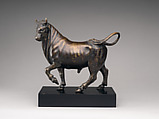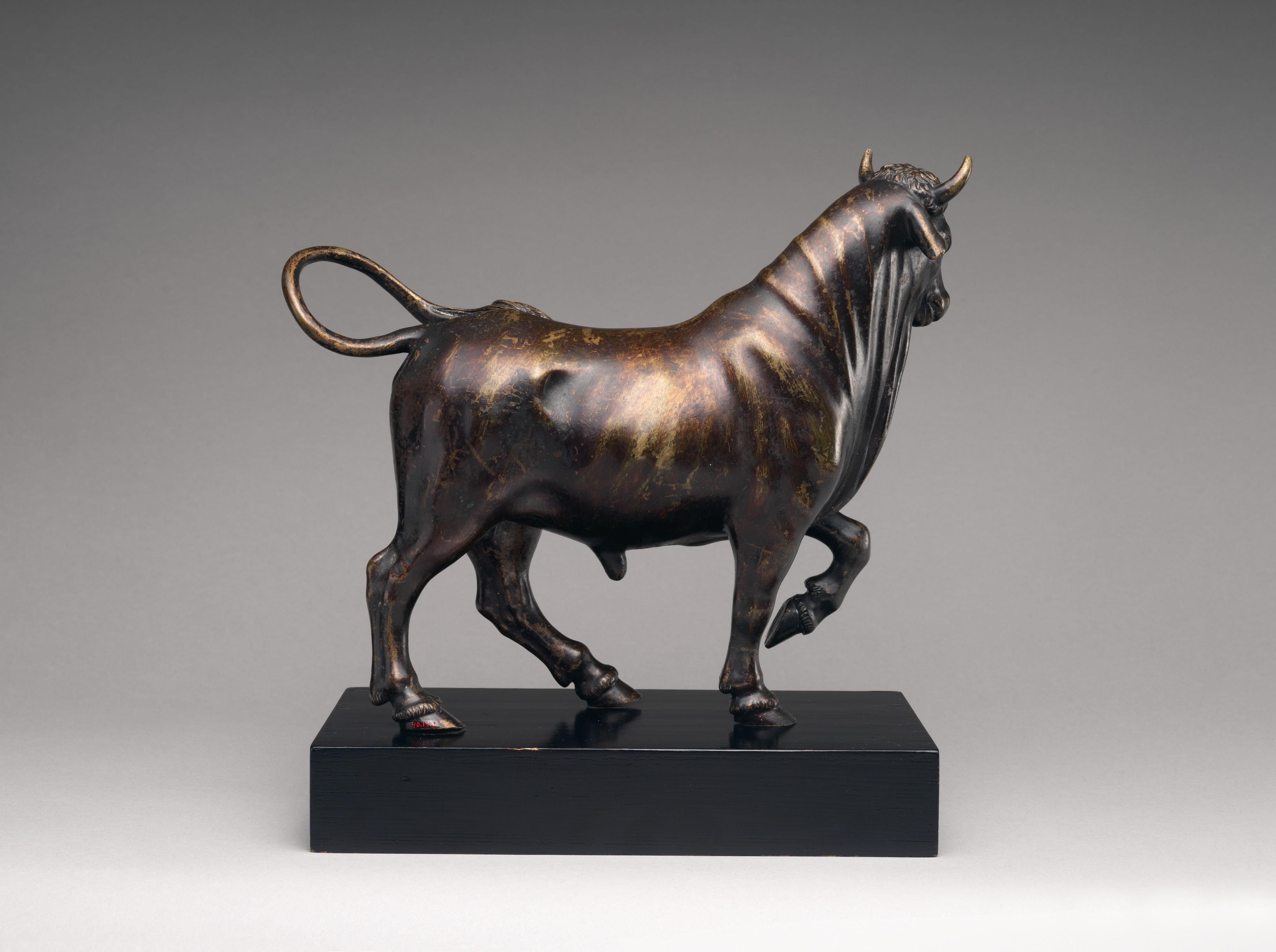Bull
After a model by Giambologna Netherlandish
Not on view
This unpublished bronze of a pacing bull is a later, possibly Northern cast of a model that ultimately derives from a Giambologna invention, which gave rise to a large corpus of variants and replicas. Documentation confirms the existence of multiple bronze bulls produced by Giambologna and his studio as well as his collaborator Antonio Susini during the master’s lifetime and in the years immediately following his death in 1608. These early bronze statuettes can be considered direct translations of Giambologna’s first pensiero. The earliest evidence of his composition being cast in bronze likely dates to 1573, when Girolamo di Zanobi Portigiani produced a bull apparently upon the request of Giambologna’s patron, the Florentine nobleman Jacopo di Alamanno Salviati, as recently shown by Dimitrios Zikos and Patricia Wengraf.[1] Another bull is recorded in the 1588 estate inventory of Francesco I de’ Medici along with a Giambologna horse and lion. The Medici casts are now in the Bargello.[2] Based on style and facture, the Portigiani cast has been associated with the bull in the Hill collection.[3]
Our bronze, which entered The Met in 1940, diverges from the Bargello and Hill exemplars and, in fact, derives from a different bull model, identified in the scholarship as “Type B.”[4] This variant can be traced back to a statuette, now in the Galleria Colonna, Rome, that was commissioned in 1628 by Jacopo di Lorenzo Salviati from Giovanni Francesco Susini, who based it on a model he inherited from his uncle Antonio.[5] The Type B composition reelaborates Giambologna’s invention (the Type A Bargello and Hill statuettes), stylizing its massive girth into a sleeker anatomy. The more diminutive muzzle is held erect, the dewlap is lighter and less fleshy, the hide between the horns is given an exquisite graphic rendering as opposed to the Type A bull’s more sculptural treatment. Moreover, while the Bargello and Hill statuettes stand on a metallic oval base, typical of Giambologna’s early small sculptures, neither the Colonna nor The Met bronze has such a support.[6]
The quality of the beautiful Colonna bronze far surpasses that of ours, with its rather perfunctory definition of volume and musculature, particularly in the reticular pattern of the dewlap folds and the linear configuration of the legs and hooves. Richard Stone’s technical analysis revealed peculiarities in the casting technique—the absence of wax-to-wax joins, the use of a single, heavy longitudinal wire running the entire length of the bull to support the core—compatible with a dating to the eighteenth and nineteenth centuries. The core appears to have been pre-cast and inserted in the mold, a practice facilitating production in larger numbers.[7] In addition, the alloy is a relatively clean leaded brass with only low levels of tin and antimony, pointing to a Northern provenance. Comparable bulls in the Herzog Anton Ulrich Museum, Braunschweig, attributed to a local workshop, and a non-Florentine cast auctioned in 2009 attest to the popularity of Susini’s model north of the Alps.[8] In this regard, it is useful to remember that a bronze likely based on this composition was recorded in the 1652 inventory of Jan van Meurs’s collection in Antwerp.[9]
-TM
Footnotes
(For key to shortened references see bibliography in Allen, Italian Renaissance and Baroque Bronzes in The Metropolitan Museum of Art. NY: The Metropolitan Museum of Art, 2022.)
1. Wengraf 2014, pp. 118–25, cat. 6; Utz 1973, p. 69, doc. V, item 12. This bronze is often confused with a bull statuette by Antonio Susini listed in the 1609 inventory of the collection of Jacopo’s son Lorenzo Salviati. Since Giambologna and Susini did not begin collaborating until around 1581, this bull cannot be the 1573 statuette, but another early example. A copy of the Susini/Salviati bull was cast by Pietro Tacca in 1611–12 as part of a diplomatic gift from Cosimo II de’ Medici to Henry, prince of Wales. See Paolozzi Strozzi and Zikos 2006, p. 242, cat. 45; Zikos 2013; for the Tacca copy, Watson and Avery 1973, pp. 503, 506.
2. Inv. 287 B, 361 B, and 348 B; see Barocchi and Bertelà 2002–11, vol. 1, p. 330. The Medici bull may have passed into the property of Don Antonio, son of the grand duke; on his death in 1621, a bull is listed in his estate inventory with an attribution to Giambologna. See Wengraf 2014, p. 118.
3. Wengraf 2014, pp. 118–25, cat. 6.
4. Ibid., pp. 121–22.
5. Inv. 1848 n. 32; see Herbert Keutner in Carinci 1990, p. 301, no. XVI.
6. Wengraf 2014, pp. 121–22.
7. The core is intact and the tail appears to be soldered on, another nod toward mass production. R. Stone/TR, October 13, 2011.
8. For the Braunschweig bulls (Bro 158, 159), see Berger and Krahn 1994, p. 103, nos. 63, 64. The other cast was auctioned at Néret-Minet Scp., Paris, June 19, 2009, lot 00201.
9. See Kugel 2008, p. 94 n. 13.
Due to rights restrictions, this image cannot be enlarged, viewed at full screen, or downloaded.
This artwork is meant to be viewed from right to left. Scroll left to view more.




